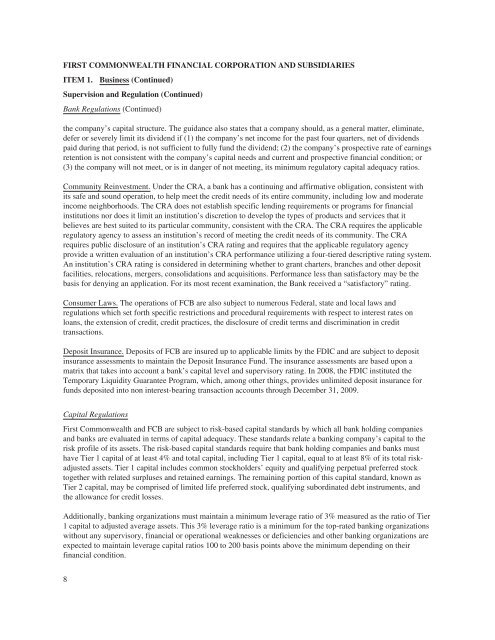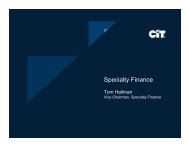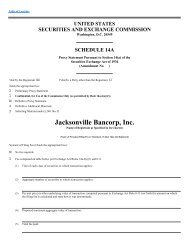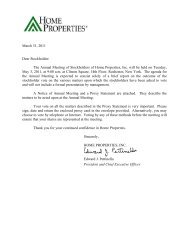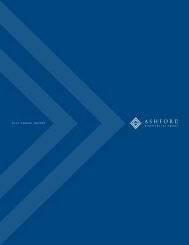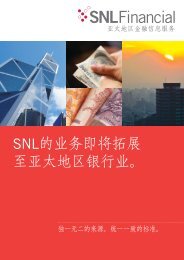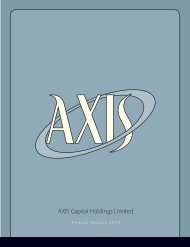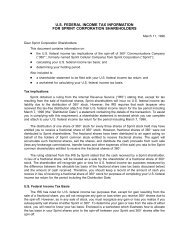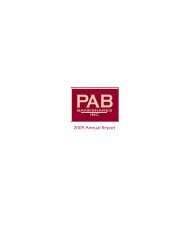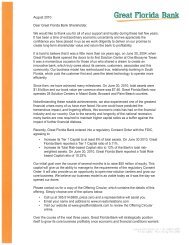Strength and Stability - SNL Financial
Strength and Stability - SNL Financial
Strength and Stability - SNL Financial
You also want an ePaper? Increase the reach of your titles
YUMPU automatically turns print PDFs into web optimized ePapers that Google loves.
FIRST COMMONWEALTH FINANCIAL CORPORATION AND SUBSIDIARIES<br />
ITEM 1. Business (Continued)<br />
Supervision <strong>and</strong> Regulation (Continued)<br />
Bank Regulations (Continued)<br />
the company’s capital structure. The guidance also states that a company should, as a general matter, eliminate,<br />
defer or severely limit its dividend if (1) the company’s net income for the past four quarters, net of dividends<br />
paid during that period, is not sufficient to fully fund the dividend; (2) the company’s prospective rate of earnings<br />
retention is not consistent with the company’s capital needs <strong>and</strong> current <strong>and</strong> prospective financial condition; or<br />
(3) the company will not meet, or is in danger of not meeting, its minimum regulatory capital adequacy ratios.<br />
Community Reinvestment. Under the CRA, a bank has a continuing <strong>and</strong> affirmative obligation, consistent with<br />
its safe <strong>and</strong> sound operation, to help meet the credit needs of its entire community, including low <strong>and</strong> moderate<br />
income neighborhoods. The CRA does not establish specific lending requirements or programs for financial<br />
institutions nor does it limit an institution’s discretion to develop the types of products <strong>and</strong> services that it<br />
believes are best suited to its particular community, consistent with the CRA. The CRA requires the applicable<br />
regulatory agency to assess an institution’s record of meeting the credit needs of its community. The CRA<br />
requires public disclosure of an institution’s CRA rating <strong>and</strong> requires that the applicable regulatory agency<br />
provide a written evaluation of an institution’s CRA performance utilizing a four-tiered descriptive rating system.<br />
An institution’s CRA rating is considered in determining whether to grant charters, branches <strong>and</strong> other deposit<br />
facilities, relocations, mergers, consolidations <strong>and</strong> acquisitions. Performance less than satisfactory may be the<br />
basis for denying an application. For its most recent examination, the Bank received a “satisfactory” rating.<br />
Consumer Laws. The operations of FCB are also subject to numerous Federal, state <strong>and</strong> local laws <strong>and</strong><br />
regulations which set forth specific restrictions <strong>and</strong> procedural requirements with respect to interest rates on<br />
loans, the extension of credit, credit practices, the disclosure of credit terms <strong>and</strong> discrimination in credit<br />
transactions.<br />
Deposit Insurance. Deposits of FCB are insured up to applicable limits by the FDIC <strong>and</strong> are subject to deposit<br />
insurance assessments to maintain the Deposit Insurance Fund. The insurance assessments are based upon a<br />
matrix that takes into account a bank’s capital level <strong>and</strong> supervisory rating. In 2008, the FDIC instituted the<br />
Temporary Liquidity Guarantee Program, which, among other things, provides unlimited deposit insurance for<br />
funds deposited into non interest-bearing transaction accounts through December 31, 2009.<br />
Capital Regulations<br />
First Commonwealth <strong>and</strong> FCB are subject to risk-based capital st<strong>and</strong>ards by which all bank holding companies<br />
<strong>and</strong> banks are evaluated in terms of capital adequacy. These st<strong>and</strong>ards relate a banking company’s capital to the<br />
risk profile of its assets. The risk-based capital st<strong>and</strong>ards require that bank holding companies <strong>and</strong> banks must<br />
have Tier 1 capital of at least 4% <strong>and</strong> total capital, including Tier 1 capital, equal to at least 8% of its total riskadjusted<br />
assets. Tier 1 capital includes common stockholders’ equity <strong>and</strong> qualifying perpetual preferred stock<br />
together with related surpluses <strong>and</strong> retained earnings. The remaining portion of this capital st<strong>and</strong>ard, known as<br />
Tier 2 capital, may be comprised of limited life preferred stock, qualifying subordinated debt instruments, <strong>and</strong><br />
the allowance for credit losses.<br />
Additionally, banking organizations must maintain a minimum leverage ratio of 3% measured as the ratio of Tier<br />
1 capital to adjusted average assets. This 3% leverage ratio is a minimum for the top-rated banking organizations<br />
without any supervisory, financial or operational weaknesses or deficiencies <strong>and</strong> other banking organizations are<br />
expected to maintain leverage capital ratios 100 to 200 basis points above the minimum depending on their<br />
financial condition.<br />
8


